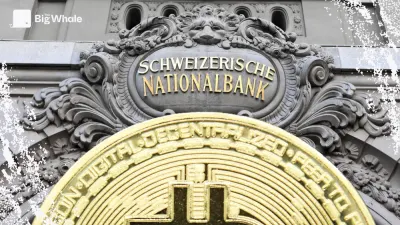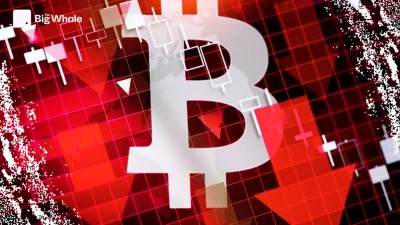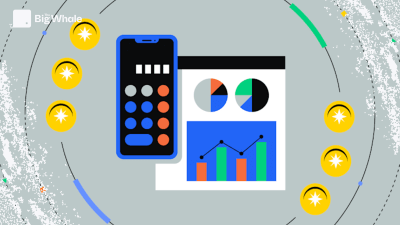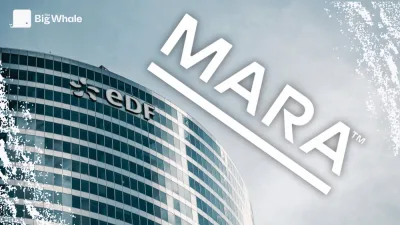TBW - Solana and memecoins: an investigation into a toxic addiction

Solana established itself in 2024 as a key player in the sector. And the figures speak for themselves: exploding trading volumes, massive user adoption, record transactions... The blockchain seems to have found its recipe for success.
But behind this meteoric rise lies a phenomenon that is as fascinating as it is controversial: the rise of memecoins, boosted by platforms like Pump.fun. So much so that we wonder if Solana could live without it.
>> Read also - Why memecoins are a lasting trend in cryptos
What's the general level of activity on Solana?
Solana continues to nibble away at Ethereum, and it's no longer just an impression: the data is unequivocal. Over the last twelve months, blockchain has established itself as an industry benchmark, driven by favourable market conditions and decisive technological advantages. Fast transactions, reduced costs for asset creation, an infrastructure suited to intensive use: these are all advantages that explain its rise in an ecosystem where asset exchange and management are at the heart of usage.
While Ethereum retains the largest total locked value (TVL) and the highest concentration of stablecoins, Solana passed a symbolic milestone in October 2024 by overtaking Ethereum in transaction volume. This trend is not new: as early as the first half of 2024, Solana was already emerging as a serious challenger. The attractiveness of its platform, particularly among retail users, has been amplified by the rise of memecoins and the seamless experience it offers thanks to its ultra-low fees.
The boom in trading on Solana's DEXs is further proof of this. In the fourth quarter of 2024, its daily trading volume surpassed that of other major blockchains. Raydium and Orca, its two main platforms, alone concentrate more than 60% of the total volume of the ten largest DEXs across all chains.
By comparison, Layer 2 solutions such as Base and Arbitrum have posted a monthly volume of barely half that of Solana since the start of 2024.
But the real revelation of this surge is being played out elsewhere: the number of active portfolios.
From September 2024, Solana has seen an explosion in the number of users, reaching a peak of 135 million unique active portfolios in November. This craze was largely driven by the explosion in memecoins, boosted by platforms such as Pump.fun.
>> Read also - Our fundamental analysis of Solana
The role of Pump.fun
Pump.fun is now establishing itself as one of the most emblematic protocols in the Solana ecosystem, enabling memecoins to be created and launched in just a few clicks, without any technical knowledge or need for initial liquidity. But is this phenomenon a technological breakthrough or simply a speculation engine?
In contrast to traditional methods requiring initial capital to feed liquidity pools on Raydium or Orca, Pump.fun automates this process through a bonding curve mechanism.
The way it works is simple: a user connects their Solana wallet, enters a name and symbol, and pays a small fee in SOL. The protocol instantly generates the token and makes it available for purchase via the bonding curve. The price then evolves according to the number of tokens in circulation and the SOL injected into the pool.
To limit rug pull risks, liquidity is automatically locked in, and the protocol takes a 1% commission on each transaction. When a token reaches $69,000 in market capitalisation, Pump.fun deposits liquidity on Raydium, rewards the creator with 0.5 SOL and permanently burns the LP, making the token completely autonomous.
This mechanism encourages a rapid rise in prices when the first purchases are made, attracting speculators but also exposing investors to brutal corrections.
Pump.fun is often compared to a gigantic casino, fuelled by success stories relayed on Twitter, where some investors have turned a few dollars into fortunes. But the reality is more nuanced: of the 18 million addresses registered on the platform, only 0.39% have made a profit of more than $10,000. For gains in excess of $100,000, this share drops to 0.048%.
This frantic quest for wealth has led to extreme behaviour. Users are willing to do anything to get attention for their memecoin, to the point of performing one absurd challenge after another. One young man filmed himself playing Russian roulette, saying he wanted to be turned into a token if he died. He died. Another, after shaving his eyebrows live when his token reached $10 million in capitalisation, promised to sit on a toilet until he reached $50 million. More recently, one investor locked himself in a cage imitating a dog, hoping to see his token cross the 25 million capitalisation mark.
These excesses illustrate the frenzy surrounding the platform and the risks associated with this race for instant gains.
Despite the criticism, Pump.fun has introduced a real innovation by democratising the creation of tokens. More accessible than ever, the platform allows creators to unite a community around a project without technical barriers.
Its model also stands out for its advanced security mechanisms. Unlike traditional launches on DEX, where rug pulls are frequent, the liquidity of tokens created on Pump.fun is locked automatically via smart contract. This protection strengthens user confidence and limits fraud, even if it does not eliminate it completely.
The success of Pump.fun is also explained by its integration within the Solana ecosystem. Since its launch, the protocol has generated around $500 million in transaction volume, with a record in January when it surpassed Ethereum in terms of revenue ($107 million).
.png)
Pump.fun is often criticised for selling SOL, but generating revenue is part of any company's business model. According to Lookonchain, the platform has transferred around 2.34 million SOLs to Kraken, representing nearly $41.64 million in sales.
However, its mechanism also results in around 162,789 SOLs being locked into bonding curves, reducing the supply in circulation. These inaccessible tokens are akin to a partial burn, indirectly contributing to the dynamics of the Solana ecosystem.
Is Pump.fun a revolution in tokenisation or simply a speculation engine boosted by the memecoin frenzy? It's hard to say.
While the protocol opens up new prospects for financing and community creation, its model is largely based on a speculative dynamic that can quickly collapse. As the market evolves, Pump.fun's ability to adapt and offer sustainable uses will determine whether this trend is sustainable... or whether it remains a bubble ready to burst.
The weight of memecoins in Solana
Memecoins are no longer a mere anecdotal phenomenon on Solana: they are now the beating heart of its ecosystem. According to the latest estimates, around 60% of the blockchain's monthly trading volume comes from these ultra-speculative assets, a figure that illustrates their weight in the network's activity.

This dominance is even more obvious when we compare Solana to the other historical memecoin blockchains. Solana alone accounts for 90% of the total volume traded among the 30 largest memecoins by market capitalisation (data as at 24 January 2025). A striking observation when you consider that Ethereum and BSC have hosted emblematic projects such as SHIB or PEPE.
Behind this explosion, one driver: the search for quick gains, which is driving a myriad of individual investors to try their luck on these tokens, often compared to digital lottery tickets.
The memecoin frenzy is clearly reflected in the number of tokens created daily on Pump.fun. Since September 2024, the platform has recorded a minimum of 10,000 new tokens every day. A threshold that literally exploded in January 2025: only three days during that month saw the creation of fewer than 50,000 tokens, a dizzying figure.
The evolution of the phenomenon follows a clear pattern: the rise of Pump.fun coincides with an increase in the volume of transactions on Solana, the two dynamics being closely linked. Since the launch of the platform, nearly 8 million tokens have been generated, illustrating the scale of this speculative wave.
But more than that, Pump.fun now dominates the creation of tokens on an inter-channel scale. Since October 2024, more than 50% of new tokens issued every day across all blockchains have come directly from this platform, a figure that speaks volumes about its influence.
While the proliferation of transactions and token creations testifies to the dynamism of the ecosystem, it also represents a full-scale test of the robustness of the Solana network.
Since its launch in 2020, the blockchain has experienced several notable outages, often linked to transactional overload:
- 14 September 2021: an explosion in traffic led to a network fork, causing a 17-hour outage.
- 1 May 2022: a massive bot attack brings the network to a standstill for 7 hours.
- 31 May 2022: a bug in the management of offline transactions interrupts Solana for 4.5 hours.
- 1 October 2022: a consensus problem linked to a misconfigured node blocks the network for 6 hours.
- 6 February 2024: after a year of stability, an outage lasting more than 4 hours requires an urgent fix.
Since this incident, Solana has not experienced any further major outages, despite steadily increasing activity, driven in particular by the memecoin wave. Where the network would have faltered in the past, it now seems to have gained in resilience.
However, the effect of congestion is not without consequences. At the peak in January 2025, coinciding with the frenzy surrounding the TRUMP and MELANI memecoins, transaction fees soared. While they usually fluctuate between 1 and 6 cents, they temporarily soared to as much as $0.40 per transaction.
While this increase is significant for Solana, it remains well below the costs seen on Ethereum. At equivalent volumes, Ethereum network congestion would have generated infinitely higher costs, confirming the relative efficiency of Solana's model despite the challenges imposed by this new speculative era.
Is Solana's equilibrium dependent on its memecoins?
Solana has established itself as a blockchain with a low cost per transaction, relying on a high volume of exchanges to ensure its economic model. Its operation is based on a combination of controlled inflation and a mechanism for burning transaction fees, aimed at managing the supply of its native token, the SOL.
At the network's launch, the annual inflation rate was set at 8%, with a programmed reduction of 15% per year until a floor rate of 1.5% was reached. At the same time, 50% of transaction fees (base fees and priority fees) were burnt, reducing the supply of SOLs in circulation.
But a major change occurred on 12 February 2025, with the activation of the SIMD-0096 update: since that date, only 50% of base fees are now burnt, while priority fees are no longer burnt.
Whether Solana can become deflationary - i.e. whether the amount of SOL burned exceeds the issue due to inflation - depends on trading volume. For this to happen, the fee burn would have to fully offset inflation, which is not currently the case.
.png)
Analysis of the burn rate (proportion of SOL emitted that is burnt) shows significant variations over time:
- March 2024: first peak around 12%, corresponding to the memecoin boom.
- November - December 2024: new significant peaks, peaking at 35% in mid-January 2025, during the frenzy around Trump and Melania tokens.
- Since February 2025 (SIMD-96): sharp drop in the burn rate, from around 17,700 SOLs burned per day to just 1,000 SOLs.
Concretely, here are the changes before and after the update:
Before SIMD-96 (previous 30 days):
- Daily emission: 76,500 SOL
- Daily burn: 17,700 SOL
- Annualised inflation: 3.6%
Since SIMD-96:
- Daily emission: 77,650 SOL
- Daily burn: 1,000 SOL
- Annualised inflation: 4.7%
Despite the massive increase in trading volume linked to memecoins, Solana has therefore never been deflationary, although speculative activity has temporarily mitigated the impact of inflation.
The next update, SIMD-228, could change this balance by introducing a dynamic inflation mechanism based on a staking target, rather than a fixed issuance schedule.
Memecoins temporarily boosted Solana's economy by stimulating transactional activity and increasing the burn of fees. This surge in activity has also benefited validators, who have received higher rewards thanks to the increase in transaction volume.
However, this impact is one-off and has not transformed Solana's economy in any lasting way. Inflation remains higher than the burn, and the network still relies on continued growth in activity to maintain its business model.
The memecoin explosion has undoubtedly boosted trading volumes on Solana, but also the price of SOL, creating strong demand for fees, liquidity and speculation. Before this wave, volumes were more moderate.
However, reducing Solana to memecoins would be a mistake. The ecosystem is much broader, with dynamic sectors such as:
- DeFi, with platforms such as Marinade and Jito.
- NFTs, where Solana remains a stronghold despite Magic Eden's multichain.
- Payments, via solutions such as Solana Pay.
- Innovative applications, such as Parcl for tokenised real estate (RWA).
In the short term, memecoins have been a beneficial business catalyst for Solana. In the long term, the network will need to capitalise on its concrete use cases to ensure its viability.
Without the memecoin effect, Solana would still be viable, but its recent growth would have been much more moderate. These ultra-speculative tokens have acted as a temporary catalyst, attracting new users and amplifying trading volumes.
>> Read also - Eclipse, the best of Ethereum and Solana?
The impact on the SOL price and market perception
The SOL price has benefited fully from the rise of memecoins, whose activity now accounts for around 60% of trading volume on Solana. This rise followed a clear pattern: the more memecoins were traded, the more SOL benefited. Each time a memecoin was created, bought or sold, a transaction fee paid in SOL was generated. Although individually modest, these fees accumulated over a massive volume exerted constant buying pressure on the network's native token.
But the most direct impact on the SOL price came from the gains made by investors. When a trader makes a large profit on a memecoin, their profits are often recouped in SOL before being converted into fiat currency or other cryptocurrencies. This mechanism fuelled a bullish loop: as the craze grew, so did demand for SOL, as the majority of liquidity pools were denominated in this token. Even if some people then resold their SOL to secure their profits, the net effect remained largely positive as long as the influx of new participants offset these sales.
However, this dependence on memecoins also showed its limits, particularly when the ecosystem was splattered by scandals. In 2024, several celebrities launched their own tokens, attracting considerable attention but also controversy. Some of these projects, promoted by Caitlyn Jenner, Rich The Kid and Soulja Boy, turned out to be "pump and dump" schemes, orchestrated by unscrupulous players seeking to manipulate prices before abandoning investors. The peak of this trend was reached in January with the launch of Donald Trump's memecoin, quickly followed by that of his wife Melania, which generated spectacular volumes before undergoing major corrections.
February 14 marked a turning point with LIBRA, a memecoin promoted by Argentine president Javier Milei. The token briefly reached a market capitalisation of $4 billion before collapsing abruptly. The crash revealed much deeper issues. Influential figures in the ecosystem, such as Ben Chow, co-founder of Meteora, were implicated, whether voluntarily or involuntarily. Faced with the growing controversy, Ben Chow eventually announced his resignation as CEO of Meteora.
The pressure on the Solana ecosystem then intensified, to the point where the creator of Pump.fun himself had to intervene. In a public statement, he condemned the practices used and the individuals involved, seeking to dissociate the platform from the abuses observed. This case has highlighted the fragility of an economic model that is too closely linked to cycles of unbridled speculation. While memecoins have propelled Solana to the top by attracting massive numbers of users and boosting demand for SOL, they have also exposed the network to controversies that could ultimately damage its credibility.
Where do the heavyweights of the ecosystem stand?
Anatoly Yakovenko, co-founder of Solana Labs, makes no secret of his interest in the memecoin phenomenon. As soon as this trend emerged in March 2024, he adopted a nuanced position, believing that these tokens are neither fundamentally good nor bad, but that their impact depends on how users use them. In a series of publications on X, he compared them to loot boxes - the surprise chests of video games - emphasizing their speculative and random nature.
Anatoly Yakovenko also drew parallels between the memecoin hype and that of DeFi, arguing that their impact on the ecosystem remained limited and less systemic. While he acknowledges the “noise” generated by these tokens, he considers that Solana, as an infrastructure, constitutes the “signal”: their proliferation on the blockchain would, in his view, be proof of its efficiency and speed. True to a resolutely optimistic approach, he declared last October that “every problem is an opportunity”, suggesting that these tokens serve as a life-size test for the resilience of crypto projects. AnatolyYakovenko, a central figure in the Solana ecosystem, has a vested interest in not criticizing a phenomenon that is generating record volumes of activity on the network.
While the Solana Foundation has not taken an official stance on the memecoin issue, some of its leaders have shared their vision. Austin Federa, in charge of strategy, took the view in 2024 that blockchain, as an infrastructure, is not intended to filter or censor the tokens created on its network. Comparing this approach to that of Internet Service Providers (ISPs), he said that an ISP is not expected to systematically block phishing emails or inappropriate content.
Nevertheless, this technology-neutral posture has its limits. Lily Liu, President of the Solana Foundation, was more critical of certain abuses. At the Consensus conference in Hong Kong, she strongly condemned what she described as “immoral” practices, notably those surrounding the LIBRA memecoin, a controversial token that sparked heated debate after its spectacular collapse.
Conlusion
The memecoin boom has played a key role in Solana's explosion since the start of 2024. The figures speak for themselves: over 60% of trading volume on the blockchain comes from these ultra-speculative assets, and it's no coincidence that many celebrities have chosen Solana as the launching pad for their own tokens. Behind this dynamic, the Pump.fun platform has emerged as a key player, facilitating the creation and mass distribution of these tokens and attracting a wave of users in search of quick wins.
Memecoins have thus become Solana's "trademark", contributing to its notoriety and adoption. But this dependence is also an Achilles heel. The ecosystem is now largely based on this speculative frenzy, raising questions about the long-term viability of the model.
However, can we really blame Solana or even Pump.fun? Admittedly, they benefit directly from this craze, but the origin of the phenomenon lies elsewhere. It's the users themselves who are fuelling the machine, driven by the lure of gain and the quest for quick profits. Far from being a simple question of infrastructure, the rise of memecoins highlights a fundamental aspect of decentralised markets: human psychology and its tendency towards unbridled speculation.
While Solana today resembles a huge casino where memes and volatility rule the roost, we should not overlook the other initiatives that are developing there. Beyond the speculation, serious and innovative projects continue to emerge on the blockchain. But one question remains: will this wave of users attracted by speculation stay for the long term, or will they migrate to another blockchain in search of the next hype? Solana has proved its ability to capture the market's attention. It remains to be seen whether it will manage to turn this excitement into sustained adoption.



